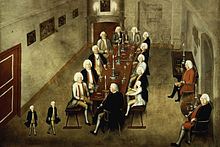Tobacco College
A tobacco college is a group of people, mostly men, who meet regularly to enjoy tobacco and socialize. Historically, the term is usually the appropriate institution under the Prussian King Friedrich Wilhelm I associated with.
history
Tobacco colleges have their origins in the Netherlands and have been part of courtly customs since the 17th century, also in the palaces of Berlin and Potsdam . King Friedrich I in Prussia had tobacco colleges held " in the opinion that the use of tobacco is good against all bad air ". During his reign, women also attended these social gatherings. Smoking was actually compulsory, but money could be bought for charity. A painting by Paul Carl Leygebe from around 1710 shows such a college in the Red Chamber or Drap d'Or Chamber, a comfortably furnished room in the Berlin City Palace . The strict court ceremony is apparently relaxed, the royal couple no longer sits directly under the canopy of the throne . Servants from the court Moors and Kammertürken serve drinks, the tobacco in the Dutch clay pipes is lit with fidibus or candlelight.
The son of Frederick I, the “soldier king” Frederick William I retained the institution of the tobacco college, but fundamentally changed its character. Now these were purely male societies who met in simply furnished rooms, smoked from clay or meerschaum pipes, drank plenty of beer and discussed politics , religion and all kinds of other topics. Here, too, the courtly rules of conduct were largely suspended, everyone should be allowed to speak freely, no one had to get up when the king entered the room. The group met in the palaces of Berlin and Potsdam, often also in the Königs Wusterhausen hunting lodge south of Berlin. The regular group of participants included high-ranking military men with whom the king preferred to surround himself, as well as occasional travelers or diplomats from whom one hoped to get interesting information.
Regularly present were also some scholars, so-called “Funny Councilors”, who were materially dependent on the court. They were listened to as experts, but were often encouraged to over-drink and engage in arguments, which, to the amusement of the rest of those present, often ended in heavy fights. The historian Jacob Paul von Gundling was the best known of these court scholars. He was employed by the king as a newspaper clerk, spent many hours in private with him and certainly influenced some of his decisions. At the same time, the king made sure that the vain and weak-willed Gundling, especially in the tobacco college, was treated with the rudest jokes and humiliated again and again - a demonstration of Friedrich Wilhelm I's fundamental aversion to the sciences, which he believed his subjects too much refined and softened.
The writer David Faßmann was also a member of the Tobacco College.
The tobacco college of the “Soldier King” was also shown in a contemporary painting. It is attributed to the painter Georg Lisiewski (according to another source: Dismar Degen ), was created in 1737 and depicts the location in Königs Wusterhausen. The barely furnished, sober room corresponded to the character and habits of the king. At the heavy oak table, the members of the college sit on simple benches without backrests. The king, at the front on the narrow side of the table, turns his back halfway to the viewer and is apparently expecting his sons, the little princes Heinrich and Ferdinand (the heir to the throne Friedrich already lived in Rheinsberg). On the opposite narrow side there are two "Funny Councilors", between them a hare, a symbol of fearfulness in Baroque imagery , but also for "hazelism", not to be taken seriously big talk.
Friedrich II. ("Frederick the Great"), the son and successor of the "Soldier King", had a decided aversion to tobacco smoking. He preferred snuff and ended the tradition of the tobacco college at the Prussian court.
present
Even today, there are regular social gatherings of pipe smokers. They sometimes use the historical term, but they also call themselves a pipe club, pipe smoker club, pipe club, etc. There are expressly so-called tobacco colleges in Berlin, Bochum , Bremen, the Bremer Tobacco Collegium , Colditz , Freiberg Potsdam and Mainz . These groupings come in very different forms. Some place great value on spontaneity and informal behavior without association , others are tightly organized on several levels - from the local, registered association with application form and probationary period ( aristocracy obliged, enjoyment connects ) to the "Association of German Pipe Smokers" (VDP) to the "Comité International of the Pipe Club “(CIPC). The umbrella organizations oversee long-term smoking competitions such as the 2007 German Championship in Cologne and the 2007 World Cup in Saint Petersburg , a team competition with 67 teams from 21 nations, with 297 participants in total, including 35 women; the “best smoker” came from Italy , his name is Stefano Caberlotto, and his smoking time was 2:54:24 hours.
literature
- Kurt Zeissler: The "long guys". History of the body and guard regiment of Friedrich Wilhelm I. Ullstein, Frankfurt am Main et al. 1993, ISBN 3-548-34968-4 .
Footnotes
- ^ Conference report: More than just "Soldier King". New highlights on the world and government of Friedrich Wilhelm I on the website of the Research Center Sanssouci, accessed on May 17, 2017.
- ↑ https://www.freiberger-tabakskollegium.de/ , accessed on June 24, 2019

